The Essential Guide to Wave Height Forecasting Apps


Intro
For anyone who enjoys the thrill of catching waves, being plugged into the right information is truly the name of the game. It’s not just about how big the waves get or the kind of surfboard you use - it’s about timing and tuning in to the right data. Wave height forecasting apps have changed the landscape for surfers, from weekend warriors to seasoned veterans. These tools are like a trusty compass guiding you through the sometimes-choppy waters of surf conditions.
Wave forecasts provide crucial insights into what you can expect when you hit the beach. But, let’s be real - navigating the sea of apps out there can feel overwhelming. Each promises to give you the lowdown on wave height, tide movements, and swell direction, but which ones actually deliver the goods? In this guide, we will take you through the essentials by exploring how these apps operate, their must-have features, and how they can impact your decision-making process when it comes to planning the perfect surf session.
Expect to learn about a range of wave height forecast apps and what sets them apart from one another. Also, we'll keep breaking down details relevant to your surfing adventures, whether you are standing at the shore looking out, or paddling out to grab that perfect wave!
Prelude to Wave Height Forecast Apps
In an age where technology intertwines deeply with our recreational pursuits, wave height forecast apps have emerged as essential tools for surfers and ocean enthusiasts alike. These apps not only inform users about the nature of the waves but also shape the overall surfing experience by providing crucial data for decision-making. With reliable forecasting, surfers can better prepare for their day on the water, ensuring they catch the best swells while maximizing safety.
The significance of understanding wave height forecasting cannot be overstated. For starters, it can directly influence the quality of surfing conditions. Surfers who grasp how wave heights fluctuate can select the right gear and determine the best spots to ride. Inaccurate predictions, on the other hand, can lead to disappointment or, worse, hazardous conditions.
Defining Wave Height Forecasting
Wave height forecasting essentially involves predicting the height of waves at beaches and surf breaks, derived from various meteorological and oceanographic data. The height of a wave is the distance between the crest, or top, of the wave and the trough, or bottom. These predictions often consider multiple factors, including wind speeds, swell direction, tidal movements, and even ocean floor topography.
The forecasting models rely heavily on the understanding of ocean dynamics and atmospheric conditions. Through complex algorithms and models, data from buoys, satellite imaging, and weather stations are collated, maximizing the accuracy of the information displayed to users. The more precise this data is, the higher the likelihood that surfers can enjoy optimal wave conditions.
The Evolution of Surf Forecast Technology
Over the years, the technology behind wave height forecasting has seen rapid advancements. A few decades back, surfers relied heavily on word-of-mouth and local knowledge coupled with rudimentary charts. Before the digital age took off, surf reports were often based on simple observations by seasoned surfers queuing at the local beach break.
Today, the landscape has morphed dramatically. Surf forecasting has transitioned into a high-tech industry. Modern apps incorporate live data feeds, real-time updates, and even user-generated reports. Surfers can now access detailed insights, including animated wave forecasts and localized conditions. What once relied on guesswork is now backed by sophisticated meteorological models, allowing surfers to make informed choices.
"The ocean is unpredictable, but with the right data, we can navigate its moods," says an experienced surfer, emphasizing the importance of technology in understanding surf conditions.
This evolution continues as developers seek to harness machine learning and artificial intelligence to further refine forecasts, pushing the boundaries of what is possible in wave height predictions. With every advancement, it opens new doors for enthusiasts, bringing anticipation and better preparedness for their adventures on the waves.
Importance of Accurate Wave Height Predictions
Wave height predictions are crucial for those who ride the waves or simply enjoy watching the surf. Accurate wave height forecasting can greatly influence a surfer's decision on when and where to hit the water. It helps in planning outings, enhancing safety, and securing a better overall experience.
One cannot overstate the value of understanding the surf conditions before diving in. It is not just about height; it’s the quality of the wave that matters too. An ideal surf day combines favorable wave heights with the right swell period and wind conditions. When the forecast aligns correctly, surfers can catch breaks that make the experience worthwhile. Hence, accurate wave height predictions can be the difference between riding magnificent sets or being stuck battling in choppy, unpleasant conditions.
Impact on Surfing Conditions
When forecast apps accurately predict wave height, surfers are empowered to make informed decisions. This goes farther than just personal enjoyment; it also encompasses the competitive aspect of surfing. Events like competitions or casual sessions with friends are made significantly better when everyone knows what to expect.
Factors that directly affect surfing conditions include:
- Wave height: Larger waves can provide better rides for experienced surfers but may pose risks for beginners.
- Swell direction: Knowing the proper direction helps surfers choose the right beach; not every spot breaks well all year round.
- Wind conditions: Wind can turn a good wave into a mess. Accurate wind forecasts help surfers plan their timing.
By leveraging forecast apps, surfers can utilize predictive tools that offer insights into changing conditions.
"The ocean is unpredictable, but with technology, we can tame it to some degree."
Safety Considerations for Surfers
While the thrill of surfing is enticing, safety must remain a priority. In many instances, inclement or unexpected wave conditions can lead to dangerous situations. Accurate wave height predictions can mitigate risks in surfing scenarios.
For surfers, understanding the ocean is akin to knowing the lay of the land. Having reliable data about wave heights aids in evaluating whether conditions are suitable. Here’s how safety is enhanced through accurate predictions:
- Avoiding hazards: Knowing when waves are too high or choppy can help surfers avoid dangerous breaks or strong currents, safeguarding against potential injuries.
- Emergency preparedness: Accurate information allows surf schools and rescue organizations to prepare adequately for conditions that may require lifeguards to be on alert.
- Skills evaluation: Surfers can determine when to step into challenging conditions versus when to take a more conservative approach based on their skill levels.
In summary, accurate wave height predictions do not only enhance the surfing experience; they are integral to the safety and well-being of surfers. As technology continues to evolve, the potential for these forecasts to become even more precise holds great promise for the surfing community.
How Wave Height Forecast Apps Function
Understanding how wave height forecast apps work is crucial for surfers who want to maximize their time on the water. These apps, at their core, harness meteorological principles and a variety of data sources to provide surfers with reliable predictions of wave conditions. By real-time tracking and forecasting, they allow surfers to make informed choices about when and where to surf, ultimately transforming how they interact with the ocean.
Meteorological Principles Behind Forecasting
The basis of wave height forecasting lies in meteorology. It encompasses several factors like wind speed, atmospheric pressure, and ocean currents, all of which play a pivotal role in determining wave formation. When high winds blow across the ocean, they create surface waves. The fetch, or distance over which the wind blows, directly influences wave height; a longer fetch typically results in larger waves. Moreover, meteorologists assess swell periods and directional patterns, predicting not just the size, but also the behavior of the waves. This understanding is critical for surfers who need to know whether the waves will be suitable for riding or if they will be more turbulent.
Data Sources Utilized by Forecast Apps

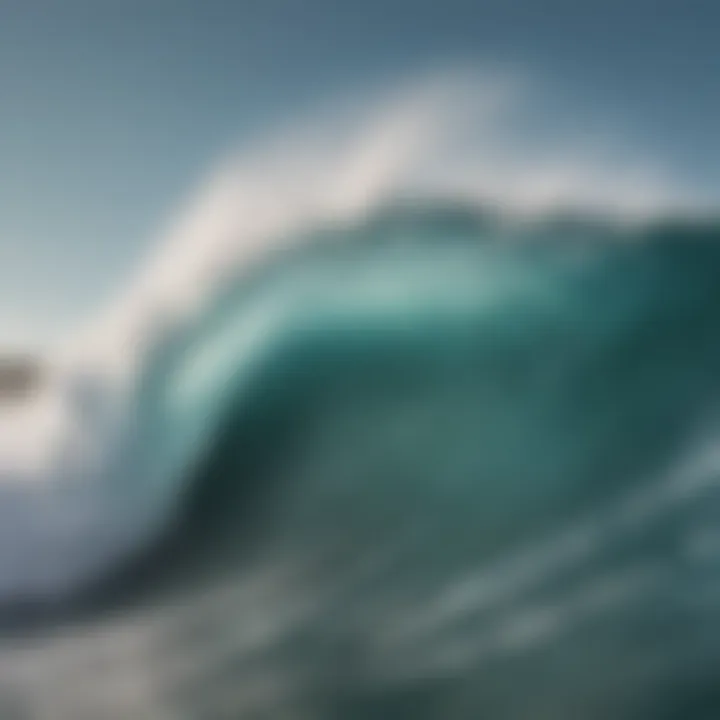
Wave height forecast apps pull information from a variety of sources to provide accurate and timely data. Here are the main data sources utilized:
Buoy Data
Buoy data plays a significant role in wave forecasting. Some buoys are strategically located all over the oceans, transmitting real-time data about wave heights and frequencies. These data points come from special devices floating on the surface that measure the ocean’s movements. What sets buoy data apart is its reliability; many professional surfers rely on this data because it is often updated every few hours. However, one limitation is that buoys may not always capture local conditions, especially in less trafficked waters.
Satellite Imaging
Satellite imaging provides a bird's eye view of ocean conditions, allowing for the observation of wave patterns over vast areas. This method uses advanced technology to capture real-time images of the water surface and wave formations. One key characteristic of satellite imaging is its ability to cover large, remote areas that are often out of reach for other forms of measurement. However, while satellite imaging is beneficial for seeing trends, it can be less precise when it comes to small, localized conditions.
Weather Models
Weather models incorporate complex algorithms that analyze historical data along with real-time observations to predict future conditions. They simulate how different weather variables interact and affect wave formations. What makes weather models particularly attractive for app developers is their ability to generate forecasts weeks into the future. Nevertheless, they can sometimes yield varying predictions due to changing weather patterns, meaning users need to stay attuned to updates regularly.
"Forecasting is both an art and a science, requiring a mix of precise data and experience to understand how best to interpret it."
With a comprehensive understanding of how these apps function, surfers can make smarter decisions, enhancing their time on the waves while promoting a deeper appreciation for the science behind surf conditions.
Key Features to Look for in Forecast Apps
When diving into the world of wave height forecast apps, understanding the key features can greatly enhance your surfing experience. With the vast array of apps available today, knowing what to look for ensures that you grab the right tools for not just safety, but also for maximizing your ride. This section highlights essential elements, their benefits, and considerations that matter for surfers at all levels.
User Interface and Experience
A smooth user interface is like a well-shaped board; if it doesn’t feel right, you won’t ride it smoothly. The design of the app should be intuitive, allowing for easy navigation, whether you’re seeking quick forecasts or diving deep into data analytics. Complex information needs to be presented clearly. A cluttered screen can confuse, especially during high-tension surfing decisions.
Consideration for the first-time user is important. Apps that support tutorial guides or demo modes help novices to grasp the capabilities without feeling overwhelmed. Look out for features like customizable home screens, where you can pin your favorite forecasts, favorite spots, or even surf communities. A responsive design that adapts to various screen sizes – be it that latest smartphone or a tablet – is essential. This ensures you’re accessing important data wherever you are.
Prediction Accuracy and Updates
The crux of any forecasting app hinges on its ability to provide accurate predictions. Predictive models rely on comprehensive data input and sophisticated algorithms. If the app you’re considering uses out-of-date models, your insight into wave heights can be as reliable as a weather vane in a storm.
It's vital to check how frequently the app updates its predictions. Some of the most reputable apps offer real-time updates that keep pace with rapidly changing environmental conditions. This aspect becomes crucial not only for surfers looking to catch the next big wave but also for instructors and safety personnel who must be aware of surf conditions at all times.
A few points to consider:
- Data Sources: Apps should clearly list their data sources. If an app pulls from buoy data, satellite imagery, and various weather models, that speaks volumes about its forecasting reliability.
- User Feedback Intensity: Check for user reviews about prediction accuracy. A community powerfully reflects an app’s standing.
Customization Options for Users
Customization is the name of the game. Each surfer has unique preferences, conditions they analyze, and spots they frequent. The app should not just fit one mold but allow flexibility in what users deem important. Options for customizing alert settings enable you to receive immediate notifications for changes in tide or significant weather shifts pertinent to your surfing zones.
Apps that allow you to track specific surf spots and save settings cater to individual profiles beautifully. You may wish to see graphs of historical wave data for those beloved secret spots you’ve been scouting for years. The option to overlay local tides data can be a game-changer, as tides have a profound influence on wave size and quality.
"In the world of surfing apps, customization can be the edge that separates the casual paddler from the fervent wave-chaser."
Finale
Finding the right wave height forecast app goes beyond mere statistics; it’s about defining how the app meets your specific needs. By focusing on user experience, accuracy, and customizable settings, surfers can enhance their decision-making processes and ultimately their experiences riding the waves. Whether you're catching the morning swell or reluctantly retreating from heavy storms, knowledge gleaned from these features can be the difference between a perfect surf day and an adventure gone wrong.
Popular Wave Height Forecast Apps Reviewed
In today's age, having technological tools at our fingertips is only half the battle. The battle for surfers is more about choosing the right tools to predict wave conditions effectively. This section dives into popular wave height forecast apps that have become indispensable for both seasoned pros and novices navigating the waves. Each app has its own unique features designed to cater to the varied needs of surfers. Being aware of these details can significantly enhance your surfing experience, allowing for decisions based on accurate information rather than guesswork.
App A: Features and Benefits
Many surfers rave about Surfline, an app that combines accurate data with user-friendly interface. Here’s what sets it apart:
- Real-Time Reports: With Surfline, surfers can access live surf reports from other surfers and professional spotters. It’s like having a buddy out there sending updates.
- Advanced Wave Height Predictions: The app utilizes high-resolution data models to deliver predictions that you can count on. It gives you a solid idea of what the ocean holds for you.
- Local Forecasts: Users can fetch spot-specific forecasts that help in planning surf trips when traveling. Local knowledge from reports can assist in finding optimal conditions, every time.
- Webcams: One handy feature allows users to check live webcams to see conditions before hitting the waves. It’s a smart way to ensure the surf is indeed looking good.
All these capabilities make it a solid choice for surfers who wish to stay in the know.
App B: Features and Benefits
Magicseaweed is a name familiar to many surfers too. It boasts strong predictive capabilities and a sleek design. Highlights include:
- Comprehensive Data Coverage: Magicseaweed draws data from multiple sources, compiling it into a single app, making it easier for surfers to see the big picture.
- User Engagement: There’s a community aspect here, where surfers can share experiences, tips, and even recordings. This can be beneficial for learning from others’ experiences.
- Customized Notifications: Users can set alerts based on preferred wave height, swell direction, and more. This ensures that nothing slides under the radar, especially for surfers who may have busy schedules.
- Long-Term Forecasts: Beyond the immediate wave heights, this app allows users to plan ahead with forecasts extending days or weeks into the future. It’s valuable for those looking to plan trips.
Overall, Magicseaweed offers a reliable and interactive resource for surf enthusiasts.
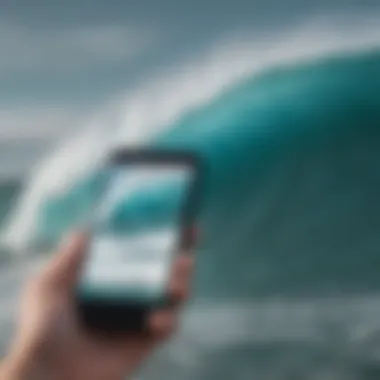
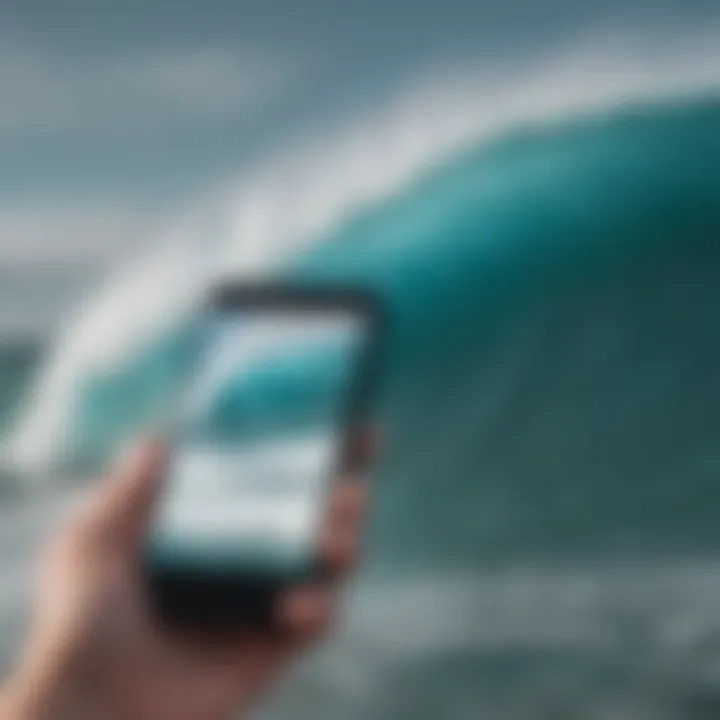
App C: Features and Benefits
Last but certainly not least, Windy is another noteworthy app in this category. While primarily known for wind forecasts, its wave-height functionalities are becoming increasingly popular. Here’s what makes it shine:
- Multifunctional Interface: Windy’s maps offer visual insights not only on wave heights but also on weather patterns, making it multifaceted for coastal adventurers.
- Wind Forecasts: Understanding wind can be just as crucial as wave height. Windy provides precise wind predictions, allowing surfers to choose the best time for their surf sessions.
- Global Coverage: The app covers surf spots on a global scale. If you ever plan to wander beyond local shores, you can rely on it to guide you.
- Custom Maps: Users can customize their maps to focus on the specific data they consider vital. This meticulous detail can help surfers tailor their experience to their needs.
By offering this wide range of capabilities, Windy becomes a versatile tool for surfers who enjoy exploring various conditions.
"Choosing the right wave height forecast app can transform a mediocre surf session into an unforgettable experience."
With these reviews, it’s clear that surfers are spoilt for choice when it comes to wave height forecast apps. Understanding individual app features is essential for making informed decisions that can enhance both safety and enjoyment in the water. Each app comes with its own set of advantages catered to different needs, underscoring the importance of selecting the right tool that aligns with your surfing style.
Integrating Environmental Considerations into Forecasts
As surfers become more aware of their impact on the environment, integrating ecological factors into wave height forecast apps is crucial. These applications not only provide insights into surf conditions but also foster a greater understanding of how ocean health directly affects wave patterns and quality. The intersection of surfing and environmental science means surfers must stay informed and conscious of their choices. By integrating environmental considerations into forecasts, we ensure a more sustainable future for the sport and our oceans.
Sustainability and Surfing
The concept of sustainability in surfing extends far beyond just picking up trash off the beach. It encompasses everything from how surfboards are made to the types of materials used in wetsuits. For instance, many manufacturers are now opting for eco-friendly materials that reduce environmental impact. The awareness around sustainability helps surfers make informed decisions about the gear they choose, which ultimately affects the demand for more sustainable products.
Moreover, understanding sustainability within the context of wave height can help surfers appreciate the delicate balance of ocean ecosystems. For example, coral reefs—often associated with great surf spots—are threatened by climate change and pollution. By being aware of these factors, surfers can advocate for healthier oceans, ensuring better wave conditions in the long run.
Taking a closer look at sustainability options:
- Recycling old surfboards can lead to innovation in design and with performance while minimizing waste in landfills.
- Sustainable wetsuits made from plant-based materials can reduce carbon footprints.
- Local surf schools that promote eco-awareness can inspire new generations of surfers to respect and protect the oceans.
The Role of Forecast Apps in Promoting Eco-Conscious Practices
Wave height forecast apps have a unique opportunity to go beyond just reporting data; they can serve as tools for environmental education. Many of these apps now include features that highlight conservation efforts and water quality updates, alerting surfers to potential hazards originating from pollution or hazardous currents.
By incorporating details such as:
- Marine conservation areas and their importance.
- Water quality indicators that alert surfers to avoid certain areas after heavy rains.
- News about climate impacts on the surfing environment.
These elements create an informed surfing community that understands the direct link between surf conditions and ocean health.
"The ocean is more than just our playground—it's our responsibility"
This mindset can lead to proactive measures among surfers, such as participating in local beach clean-ups or advocating for regulations to protect marine life. By making informed choices and adjusting their habits, surfers can be a force for positive change.
User Experiences and Case Studies
Understanding user experiences and real-life case studies is vital in grasping how wave height forecast apps perform in everyday situations. It brings a practical perspective to theoretical insights, illustrating their value and relevance for surfers of all skill levels. By examining how different surfers interact with these apps, we uncover their effectiveness, features most loved, and pitfalls to avoid. This section deeply dives into the nuanced perspectives of both beginners and seasoned surfers who engage with these digital tools for wave predictions.
Beginner Surfer Perspectives
For many, the world of surfing can be overwhelming. As a beginner, the last thing someone wants is to be floundering around in waves that are beyond their current ability. New surfers commonly rely on forecast apps to aid their decision-making process. They often seek clarity and simplicity in user interfaces. Such factors ensure they can quickly glean vital information without becoming bogged down by complex data.
From the perspective of a novice, an app’s design can be just as important as its accuracy.
"If I can’t find what I’m looking for within a couple taps, I’m likely to toss it aside," one beginner mentioned.
Many beginners rave about apps that not only forecast wave height but provide additional context like tide schedules and wind speed. These features assist them in planning their outings. Safer environments encourage more practice and higher confidence levels. It’s noted that community features, where users can share localized insights, are appreciated as they add a social element to something that can feel quite solitary. Newer surfers often report that when they successfully choose the right day to ride due to an app's accurate predictions, it dramatically boosts their enthusiasm for the sport.
Professional Surfer Insights
Professional surfers experience wave height forecast apps in a markedly different light. Their needs stretch beyond just knowing wave size; they seek high precision and real-time updates that can adjust to the ever-changing surf conditions. For them, being caught off-guard by a sudden shift in weather or wave height can mean the difference between a winning run and a missed opportunity.
Many pros rely on the advanced features offered by apps like high-resolution satellite imaging and wave models. They often emphasize the significance of understanding the underlying meteorological data.
A seasoned pro once shared, "I look for apps that analyze not just the current conditions but also predict trends. This knowledge sets me up not just for today, but for the entire week ahead."
Furthermore, professional surfers benefit from case studies showcasing pivotal moments where timely information from apps has led to successful outcomes. For instance, insights from the 2019 World Surf League finals illustrate how one competitor used app data to select optimal session times, thus enhancing their performance on key waves.
In sum, professionals tend to prefer apps that go deeper. They crave applications that feed their desire for rich data for strategic planning, while also allowing quick feedback to potentially alter their course mid-session.
Evaluating Forecast Reliability
Reliability in wave height forecasting isn't just a matter of numbers; it's about trust and safety on the water. For surfers, instructors, and even eco-enthusiasts, understanding how to evaluate the reliability of forecast apps is crucial. With the continual advancements in technology and methodology, users need to become savvy consumers of this information.
When assessing a forecast app, several key elements come into play. Accuracy is the lifeblood of any forecasting model; if the waves don’t match what’s predicted, it could lead to hazardous conditions or missed opportunities for a great ride. Therefore, it’s important to consider the data sources behind the forecasts. Are they relying solely on buoy data, or do they integrate satelitte imaging and advanced weather models? Each data point enriches the forecasting tools.
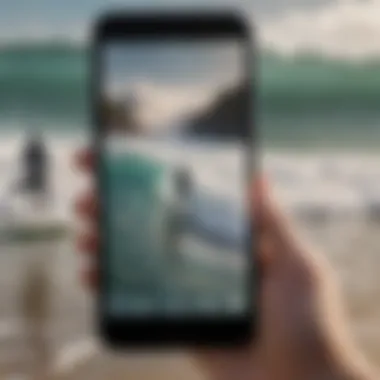
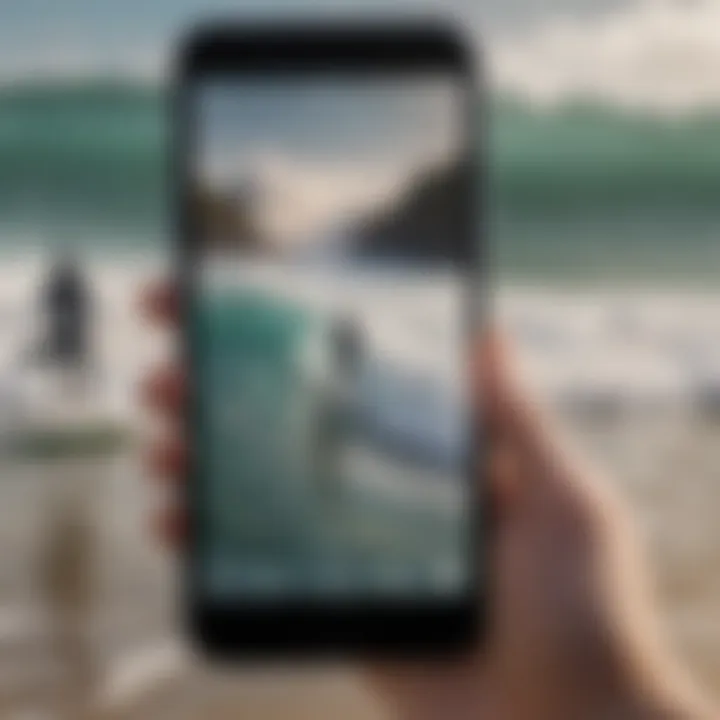
Another aspect to ponder is the frequency of updates. An app providing real-time updates is invaluable, as conditions can shift with the wind and tides, leaving surfers to face unexpected challenges. A forecast might look golden at dawn, but by noon, reality can diverge in surprising ways.
Despite the best algorithms and models, limitations always exist. It’s essential to balance expectations with the inherent uncertainties in meteorological predictions. No model is perfect.
"Understanding the strengths and weaknesses of forecast apps is the first step toward smarter surfing. Reliable data can make or break a session on the waves."
Understanding Forecast Models
Forecast models form the backbone of wave prediction technology. To truly appreciate their reliability, it’s worth diving into how they operate. Most apps employ numerical weather prediction (NWP) models. These sophisticated systems use mathematical equations to simulate atmospheric conditions. They take into account factors like wind patterns, atmospheric pressure, and ocean currents.
However, not all models are created equal. Each has its own strengths and geographical biases. Models like the GFS (Global Forecast System) have broader coverage but might lack the granularity in local, coastal conditions. Alternatively, the WRF (Weather Research and Forecasting) model can delve deeper into smaller areas, offering highly detailed predictions, yet it might require more computational power. Users should investigate how their chosen apps employ these models and what analyses they conduct to refine their forecasts.
Limitations of Current Technology
While technology in wave forecasting has made significant leaps, it’s essential to acknowledge its limitations. One major challenge is the inherent unpredictability of nature. Mother Nature has a way of throwing curveballs, and forecasting models may not capture every sudden change in wind or oceanic conditions.
Another important consideration is the data quality. For instance, buoy measurements can vary, influenced by various factors including local topography and water temperature. Moreover, satellite data can sometimes come with a delay, leaving forecasters scrambling to interpret changing conditions in real time.
In addition, many forecast apps cater largely to short-term predictions, often stretching reliability beyond three days. Beyond that, accurately forecasting wave heights can become a gamble due to compounding uncertainties. Therefore, surfers should remain vigilant, cross-referencing multiple sources and understanding the limitations of the technologies involved.
By keeping these nuances in mind, surfers can make informed decisions, enhancing both safety and enjoyment while navigating the waves.
Future Trends in Wave Height Forecasting
As technology moves ahead like a speeding train, the future of wave height forecasting apps is glowing brighter than ever. Surfers, instructors, and eco-enthusiasts alike are all sensing the winds of change, and understanding these trends is paramount for optimizing the surfing experience. By keeping tabs on advancements in this field, users can better navigate the ocean's whims and ideally catch that perfect wave. The discussion below focuses on key elements shaping these apps, their benefits, and the critical considerations surf enthusiasts should be aware of.
Technological Innovations
In the realm of wave height forecasting, innovation isn’t just a buzzword; it’s a powerful tool that can enhance predictability and user experience. The incorporation of artificial intelligence (AI) and machine learning algorithms is refining how data is processed and interpreted. These technologies allow apps to analyze immense data sets more rapidly and with greater accuracy. This means more precise forecasts of wave heights and ocean conditions, ultimately guiding surfers on the best days to hit the water.
Moreover, advancements in remote sensing technology are proving to be game changers. High-resolution satellite imaging is allowing forecasts to be based on real-time ocean conditions rather than static models. For example, platforms using synthetic aperture radar can detect minute changes in wave patterns that would typically go unnoticed to the naked eye.
- Augmented Reality (AR) is surfacing as a next-level feature, allowing users to visualize wave conditions in their local surf spots right from their devices. Imagine standing on the beach, holding your phone up, and viewing a real-time overlay of wave height predictions superimposed on the actual ocean! This kind of engagement can make decision-making swift and informed.
Of course, with innovation there comes the responsibility of educating the user base. As these technologies evolve, so must our understanding of how to interpret the data provided.
Increasing User Interaction and Feedback
User interaction is another important frontier in the development of wave height forecast apps. Traditionally, forecasts have relied heavily on meteorological experts and algorithms without room for the users' voices. However, the landscape is changing.
Apps now integrate user feedback, allowing surfers to share their experiences directly through the platform. This two-way interaction not only enriches the data but also assists developers in pinpointing where improvements are necessary. For example, if multiple users report discrepancies between their experiences and the forecasted conditions, this can prompt a reassessment of the algorithms in use.
"Listening to the community helps us tailor our services and improve reliability, making sure we keep folks out there enjoying their time in the water," says a developer of a leading surf forecasting app.
Additionally, community forums are becoming more robust within apps, enabling users to engage with one another. For instance, seasoned surfers can share insights on specific wave patterns, providing an informal yet invaluable resource for beginners trying to make sense of conditions.
In summary, the combination of cutting-edge technology and enhanced user interaction presents a comprehensive view of future trends in wave height forecasting. As surfers become more tech-savvy and the apps themselves become increasingly intuitive, the relationship between humans and the ocean is primed to reach new heights.
Ending and Recommendations
As we reach the end of our journey examining wave height forecast apps, it becomes clear that these tools are not merely convenient gadgets for surfers—they are vital companions on the water. The significance of accurate wave height predictions in ensuring pleasant and safe surfing adventures cannot be overstated. The fusion of technology and oceanic insight shapes how we experience the waves, turning guesswork into informed choices.
In assessing the reliable functionalities of these apps, surfers can find a plethora of features that cater to various needs. For instance, understanding local conditions can make or break a session. Wind direction, swell intervals, and even tides play a pivotal role in shaping the surf, and apps that incorporate these elements allow surfers to strategize effectively. By leaning on predictive technologies, users can ensure that they are riding the best waves while remaining anchored to safety.
Moreover, as the surfing community continues to grow, so do the capabilities of these apps. Not only do they enhance the surf experience, but they can also nurture a healthy eco-conscious mindset among surfers. Many platforms connect users with sustainability features or encourage responsible surfing practices. This gives surfers a chance to protect the environments they cherish, making a positive impact.
"Technology is not just about convenience; it's a bridge to understanding nature better."
Thus, selecting the right app revolves around more than just aesthetics or ease of use. It's about crafting a tool that boosts confidence and informs decisions on the water. The next segment reveals how to discern the app that best meets one’s surfing needs.
Summary of Insights on Wave Height Apps
In a nutshell, the examination of wave height forecast apps revealed several key insights. These applications serve as an essential resource for surfers, providing access to real-time data that contributes to better decision-making. A few notable points include:
- Real-time Data: Up-to-date information on wave conditions, which helps surfers predict the best times to hit the water.
- User-friendly Interfaces: Many apps are designed with the surfer in mind, ensuring that even novices can easily navigate through complex data.
- Customization: The ability to tailor notifications and data points according to personal preferences, allowing users to focus on what truly matters to them.
Overall, these insights underline the importance of integrating such technological advancements into one’s surfing toolkit.
Practical Tips for Selecting an App
When it comes to choosing the right wave height forecast app, a few practical considerations come into play. Here are some pointers worth contemplating:
- Check Multiple Sources: Don’t rely solely on one app. Cross-reference forecasts with different apps to get a more balanced view.
- Read User Reviews: Feedback from fellow surfers can provide context and insights into an app's reliability and functionality.
- Explore User Interface: An intuitive design can significantly enhance the user experience. If an app feels cluttered or complex, it might not suit your needs.
- Keep an Eye on Updates: Apps that are regularly updated tend to improve in accuracy and usability over time.
- Local Knowledge: If possible, choose an app that offers information tailored to your specific surfing location, as conditions can vary tremendously from one spot to another.
Adhering to these tips can help ensure that the selected app not only meets expectations but also enhances the overall surfing experience. As the ocean continues to ebb and flow, being armed with the right knowledge rightfully makes every surfer a more adept participant in the sport.















